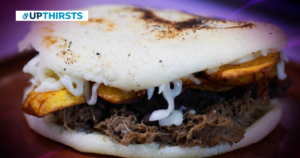Arepas Vs Pupusas Vs Gorditas: Cornmeal Clash of Titans
Arepas vs. Pupusas vs. Gorditas: Unraveling the Culinary Delights
When exploring the rich tapestry of Latin American cuisine, three iconic dishes stand out: Arepas, Pupusas, and Gorditas. These delights bring unique flavors and cultural significance, each hailing from a distinct region. Let’s break down the factors that differentiate these delectable treats:

Arepas:
1. Origin and Heritage:
Dive into the roots of Arepas, tracing their origin to Venezuela and Colombia.
Explore the cultural significance of Arepas in daily life and celebratory occasions.
2. Ingredients and Preparation:
Highlight the key ingredients, such as cornmeal, and the diverse fillings used.
Discuss various cooking methods that contribute to Arepas’ versatility, from grilling to baking.
3. Flavor Profiles:
Emphasize the distinct taste of Arepas, characterized by the crispy exterior and soft interior.
Showcase popular fillings like cheese, ham, or shredded beef contributing to the flavor medley.
4. Serving and Pairing:
Offer insights into traditional ways of serving Arepas, whether enjoyed plain or filled.
Suggest beverage pairings, such as Colombian coffee or tropical fruit juices, to enhance the dining experience.
Pupusas:
1. Cultural Origins:
Explore the Salvadoran roots of Pupusas and their integral role in the country’s culinary heritage.
Discuss the cultural significance of Pupusas in social gatherings and festivals.
2. Dough and Fillings:
Detail the process of making Pupusa dough using masa harina and water.
Showcase the diverse fillings that contribute to the dish’s variety, including cheese, beans, and loroco flowers.
3. Cooking Techniques:
Highlight the traditional griddle-cooking method that imparts a delightful golden crust to Pupusas.
Discuss variations like revueltas, queso con loroco, and more to showcase the breadth of Pupusa options.
4. Accompaniments:
Recommend classic accompaniments like curtido (cabbage slaw) and salsa roja to complement Pupusas.
Explore how Salvadorans enjoy Pupusas with a side of refried beans or tomato sauce.
Gorditas:
1. Regional Roots:
Trace the origin of Gorditas to Mexican cuisine, specifically the central and northern regions.
Discuss the historical and cultural significance of Gorditas in Mexican culinary traditions.
2. Dough Varieties and Fillings:
Differentiate between the two main types of Gordita dough: masa preparada and masa crude.
Showcase the range of fillings, from savory options like picadillo to sweet choices like caramelized sugar.
3. Cooking Styles:
Detail the cooking methods, including frying or grilling, that give Gorditas their distinctive textures.
Discuss variations such as gorditas de chicharrón, emphasizing regional diversity.
4. Garnishes and Toppings:
Explore the toppings and garnishes that elevate Gorditas, including salsa, guacamole, and Mexican crema.
Suggest creative combinations to personalize the Gordita experience.
In summary, while Arepas, Pupusas, and Gorditas share some similarities as beloved staples of Latin American cuisine, their unique origins, ingredients, flavors, and preparation methods set them apart, offering a diverse culinary journey for food enthusiasts to explore.
Culinary explorations can often lead us down delightful paths where we encounter diverse food cultures and taste the heart of different communities. Central and South American cuisine, in particular, offers a gastronomical journey filled with flavor, comfort, and tradition. Among the myriad dishes that hail from this region, three stand out and often become the subject of rigorous debate: Arepas, Pupusas, and Gorditas. Each has its unique charm, taste, and texture, and picking a favorite can be as difficult as choosing a favorite song or movie. So, come join me as we embark on this delicious journey of understanding, comparing, and appreciating the diversity of these iconic Latin treats in our “Arepas vs Pupusas vs Gorditas” showdown
An Introduction to Arepas, Pupusas, and Gorditas
To fully appreciate the culinary brilliance of these three dishes, it’s essential to understand their origin, how they’re made, and what they symbolize in their respective cultures.

Arepas
Let’s start with Arepas, a type of food made of ground maize dough, and prominent in the cuisine of Colombia and Venezuela. A staple dish for many families, Arepas are versatile and delicious, often served with a variety of fillings or used as a side to other dishes. The arepa is a simple, uncomplicated flatbread, but boy, is it power-packed with flavor! To an outsider, it may seem modest, but it speaks volumes about the rich culture from which it originates.
Pupusas
Next, we travel to El Salvador to meet their national treasure – the Pupusas. Handmade thick stuffed tortillas embody a mix of flavors that are quite simply, inexplicably good. Be it stuffed with cheese, beans, or pork, a well-made pupusa is a package of pure joy. Pair it with a tangy side of curtido, and you’re in food heaven! The art of making pupusas is beautiful to witness, and almost as satisfying as eating them.
Gorditas
Finally, we arrive in Mexico, the land of spices and Gorditas. Translating to “little fat ones,” these are thick tortillas that puff up when cooked, creating a hollow center to pack in all those wonderful fillings. Gorditas are a celebration of flavors and cultures and are as much about the process of making them as they are about the enjoyment derived from eating them.
Comparing Arepas, Pupusas, and Gorditas

When appreciating dishes from different cultures, it’s always enlightening to draw comparisons and understand the subtleties that set each one apart. So how do Arepas, Pupusas, and Gorditas hold up in direct comparison?
Arepas
Originating from Colombia and Venezuela, arepas are versatile dishes made of ground maize dough or cooked flour. They can be grilled, baked, fried, or even steamed. Arepas strike a balance between crisp and soft, and the best part is they are gluten-free. Typically, you can enjoy Arepas filled with meat, and cheese, or even have it plain.
Pupusas
Pupusas from El Salvador are very similar to Arepas but with distinct differences. Similar to Arepas, they are made with corn flour, but instead of being filled after being cooked, the fillings (which commonly include cheeses, squash, or refried beans) are added before they are cooked. This results in the flavors merging beautifully, creating a savory treat that’s tougher to resist.
Gorditas
Gorditas, native to Mexico, might remind you at first glance of a thick tortilla. ‘Gordita’ translates to ‘little fat one’, which is an endearing reference to its puffy appearance. In contrast to Arepas and Pupusas, Gorditas are made from masa (a dough from ground nixtamalized corn) and are usually filled post cooking with delectable fillings like meat, cheese, or salsa.
Here’s a comparison table highlighting the key points:
| Arepas | Pupusas | Gorditas | |
|---|---|---|---|
| Origin | Colombia/Venezuela | El Salvador | Mexico |
| Main Ingredient | Maize Dough/Cooked Flour | Corn Flour | Masa |
| Cooking Methods | Grilled, Baked, Fried, Steamed | Cooked with Fillings | Usually Fried |
| Fillings | Meat, Cheese, or Plain | Cheeses, Squash, Refried Beans | Meat, Cheese, Salsa |
| Gluten | Gluten-Free | Depends on Corn Flour used | Depends on type of Masa used |
Although Arepas, Pupusas, and Gorditas may seem similar at first glance, their unique features make them distinct culinary experiences, offering a taste of the rich cultural heritage they come from.
In the grand debate of Arepas vs. Pupusas vs. Gorditas, it’s not about finding the best, but celebrating the taste, preparation, and cultural significance of each of these delightful treats.
Pairings and Servings: What Goes Well With Arepas, Pupusas, and Gorditas

Food, like any art form, is never enjoyed in isolation. The right complementary elements not only enhance its taste but create an offering that transcends the sum of its realities. Let’s delve into the perfect pairings and servings that bring out the best in Arepas, Pupusas, and Gorditas.
Arepas
Arepas, a staple in Venezuelan and Colombian cuisines, often serve as a meal on their own due to their rich stuffing. However, they’re usually also accompanied by:
- Hot Sauce: A good tangy hot sauce adds a bit of zest and spiciness to the inherent mild flavors.
- Guasacaca Sauce: Venezuela’s avocado-based green delight, it adds a smooth and savory complement.
Pupusas
Pupusas, El Salvador’s pride, tend to come with a crunch that beautifully contrasts with their soft, doughy insides. Here are a few popular pairings:
- Curtido: A fermented cabbage slaw, it provides a tangy crunch with a hint of heat.
- Salsa Roja: This delectable red sauce pairs brilliantly with the savory pupusas, enhancing their taste palate.
Gorditas
Follow the Mexican tradition of smothering your Gorditas with some standard accompaniments:
- Salsa: A delicious condiment, be it salsa verde (green) or salsa roja (red), is usually a staple.
- Crema: A Mexican sour cream, that amps up the richness of your Gorditas.
- Queso Fresco: Sprinkle some fresh cheese for a dash of creaminess.
Each of these dishes has its myriad of pairings which lend a whole new layer of flavor, taste, and enjoyment. To experience them fully, the best way is to try these combinations yourself and discover the ones that titillate your taste buds the most.
Health Benefits and Nutritional Content of Arepas, Pupusas, and Gorditas

When it comes to nutrition, these three staples from Latin America have their unique benefits. This, of course, can vary based on the specifics of the ingredients used and the preparation method.
- Arepas: These are primarily made from cornmeal, which is naturally gluten-free, making Arepas a safe choice for those with gluten intolerances. A basic arepa provides an excellent source of complex carbohydrates. When stuffed with healthy fillings like beans, grilled vegetables, or lean meats, they transform into a whole meal with balanced nutrients.
- Pupusas: Essentially, these are maize tortillas filled with a variety of ingredients. Like Arepas, they are gluten-free. The nutritional value highly depends on the fillings. Generally, they are rich in carbohydrates, and when filled with beans and cheese, protein as well.
- Gorditas: Translating to ‘little fat ones’, Gorditas are made from masa, or cornmeal dough. They are often stuffed with cheese, meat, and other fillings. The cornmeal provides a good helping of fiber, and when combined with protein-rich fillings, they offer a balanced array of essential nutrients.
Remember, while these treats provide beneficial nutrients, they should be eaten in moderation as part of a balanced diet due to their usually high carbohydrate content.
Where Can You Find Authentic Arepas, Pupusas, and Gorditas?
The taste of a food item is crucially tied to its place of origin. The authentic versions of Arepas, Pupusas, and Gorditas are best enjoyed in their native countries of Venezuela, El Salvador, and Mexico, respectively. However, with the growing popularity of Latin American cuisine, you’re likely to find them in Latin restaurants around the world.
If you’re in New York City, Caracas Arepa Bar is well-known for its authentic Venezuelan Arepas.
In Los Angeles, Atol de Elote serves Salvadoran pupusas that stay faithful to the classic recipe.
For Gorditas in Chicago, Gorditas Loli’s is an established favorite among locals.
But the best part? These warm, comforting dishes can be made right in your own kitchen, with recipes easily available online.
Conclusion
After this delightful culinary exploration, it’s clear that Arepas, Pupusas, and Gorditas each bring a unique flavor profile and sensory experience to the table. Whether it’s the tender and crisp Arepas from Venezuela and Colombia, the mouthwatering stuffed delights of Pupusas from El Salvador, or the hearty and diverse Gorditas of Mexico, there is no contest when it comes to the charm of Latin American cuisine.
The real victory lies in enjoying these dishes in their most authentic form, savoring each bite, and appreciating the rich cultural heritage they carry. Remember, the best food is the one that not only feeds our stomach but our soul. And Arepas, Pupusas, and Gorditas do just that—each in their own distinct, memorable way.
There we have it; now you’re in the know about the yellowtail scallion roll. It’s an exquisite blend of fresh yellowtail and crisp scallions, all lovingly encased in a roll of seasoned sushi rice and nori. Whether you’re a sushi novice or a seasoned pro, the yellowtail scallion roll opens up a realm of fascinating flavors and textures for you to discover.
The Yellowtail Scallion Roll, a celebrated creation in the world of sushi, is a testament to the artistry and culinary ingenuity that defines Japanese cuisine. This exquisite roll, often found on the menu of sushi establishments around the globe, combines the rich, buttery taste of yellowtail with the crisp freshness of scallions, creating a harmonious marriage of flavours and textures that captivates sushi enthusiasts.
At the heart of the Yellowtail Scallion Roll is the choice of fish—yellowtail, known as “hamachi” in Japanese. Renowned for its delicate yet flavorful profile, yellowtail offers a buttery texture that effortlessly melts in the mouth. Sushi connoisseurs often prefer this fish for its subtle sweetness and how it complements other ingredients in rolls.
The roll typically features a thinly sliced yellowtail, allowing the natural richness of the fish to shine. The delicate slices are meticulously arranged atop a bed of seasoned sushi rice, ensuring each bite delivers a perfect balance of rice, fish, and accompanying elements. Adding scallions or green onions brings a refreshing and slightly spicy crunch to the roll, elevating its overall texture and flavour profile.
One of the defining characteristics of the Yellowtail Scallion Roll is its minimalist approach, highlighting the quality of the ingredients without overwhelming the palate. The simplicity of the roll is a testament to the precision and skill of sushi chefs who understand that, sometimes, less is more. The focus on the interplay between the buttery yellowtail and the bright scallions allows diners to appreciate the nuances of each component.
The assembly of the Yellowtail Scallion Roll is an art form in itself. Sushi chefs take care to arrange the yellowtail slices with precision, ensuring an aesthetically pleasing presentation. The roll is then expertly rolled using a bamboo mat covered in a sheet of seaweed (nori). The result is a cylindrical masterpiece showcasing vibrant colours and textures.
Accompanying the Yellowtail Scallion Roll is often a drizzle of soy sauce or a dollop of wasabi for those who enjoy an extra kick. Pickled ginger is also served alongside, providing a palate cleanser between bites and enhancing the overall sushi experience.
While the Yellowtail Scallion Roll may seem simple, its popularity lies in its ability to offer a refined and sophisticated sushi experience. Each bite tells a story of the sea—of fresh yellowtail caught in pristine waters, scallions dancing in the breeze, and seasoned rice that binds it together. The roll’s popularity extends beyond the traditional sushi bar, making it a sought-after choice for seasoned sushi enthusiasts and newcomers to Japanese cuisine.
Like many sushi creations, the Yellowtail Scallion Roll has become a canvas for experimentation and variation. To add depth to the flavour profile, some chefs may add subtle embellishments, such as a drizzle of citrus-infused ponzu sauce or a sprinkle of sesame seeds. Others might incorporate microgreens or edible flowers for a visually stunning presentation. Despite these variations, the essence of the Yellowtail Scallion Roll remains true to its core—celebrating the purity and quality of its key ingredients.
Beyond its taste and presentation, the Yellowtail Scallion Roll symbolizes the culinary bridge between tradition and innovation. While rooted in the fundamentals of sushi craftsmanship, it embraces contemporary diners’ evolving preferences and adventurous palates. This adaptability has contributed to its enduring popularity, making it a fixture in sushi bars and restaurants that strive to offer a diverse and satisfying sushi experience.
In the world of sushi, where precision and simplicity are revered, the Yellowtail Scallion Roll is a testament to the beauty that can be achieved with a thoughtful combination of ingredients. Its allure lies not just in its taste but in how it reflects the artistry of Japanese culinary traditions. As diners savour each bite of the Yellowtail Scallion Roll, they partake in a culinary journey that transcends borders and invites them to appreciate the elegance of simplicity in the world of sushi.
Exploring the world of food and cooking is an adventure that never ends. Each flavor, each ingredient, and each alternative to a well-loved staple such as chili garlic sauce opens up a realm of delicious possibilities. From fiery Sriracha to aromatic garlic paste, through Louisiana-style hot sauce to Chiu Chow chili oil, there is a substitute to fulfill every palate and every dish. Homemade chili garlic sauce, full of personal flavor preferences, may end up being your pick of the day.
Remember, the best part of cooking is experimentation and discovering what works best for you. So, next time you run out of chili garlic sauce, look at it as an opportunity to experiment with a new flavor. Who knows, you just might find your new favorite ingredient among these suggested chili garlic sauce substitutes. And the exploration doesn’t need to stop here. Your culinary journey is as limitless as your imagination. Happy cooking!
In the world of condiments that bring heat, flavor, and a punch of umami to the table, chili garlic sauce stands out as a versatile and beloved choice. The best chili garlic sauces are a carefully crafted fusion of spicy red chilies and pungent garlic, creating a condiment that elevates a wide range of dishes with its bold and savory profile. Let’s delve into the world of chili garlic sauce and explore some of the top contenders that have earned a reputation for being the best in the market.
- Huy Fong Foods Sriracha Chili Garlic Sauce: Known for their iconic Sriracha sauce, Huy Fong Foods has extended their mastery to chili garlic sauce with this stellar offering. The Sriracha Chili Garlic Sauce combines the signature heat of red chilies with the robust flavor of garlic, resulting in a well-balanced condiment that adds depth to stir-fries, noodles, and marinades. The chunky texture of the sauce provides bits of garlic, enhancing both the taste and visual appeal of dishes.
- Lee Kum Kee Chili Garlic Sauce: A brand synonymous with high-quality Asian sauces, Lee Kum Kee delivers a Chili Garlic Sauce that has become a pantry staple for many. This sauce boasts a rich and aromatic blend of red chilies and garlic, creating a complex flavor profile that enhances a variety of cuisines. The smooth consistency of Lee Kum Kee’s Chili Garlic Sauce makes it easy to incorporate into dressings, dips, and as a flavorful accompaniment to grilled meats and seafood.
- Sambal Oelek Chili Paste by Huy Fong Foods: While Huy Fong Foods is renowned for its Sriracha, the Sambal Oelek Chili Paste is another gem in their lineup. This chili paste, made from crushed red chilies and garlic, offers a pure and unadulterated heat that allows the user to tailor the intensity to their liking. Its simplicity and versatility make it a favorite for those who prefer the unmasked essence of chili and garlic in their culinary creations.
- Kumana Avocado Hot Sauce – Chili Picante: Offering a unique twist on traditional chili garlic sauce, Kumana Avocado Hot Sauce infuses the bold flavors of chili and garlic with the creamy richness of avocado. This innovative combination creates a sauce that not only brings heat but also a delightful creaminess that pairs exceptionally well with tacos, grilled meats, and sandwiches. Kumana’s Chili Picante variety adds a zesty kick to dishes while introducing a touch of tropical flair.
- Sky Valley Sriracha Chili Garlic Sauce: Sky Valley’s take on chili garlic sauce stands out for its commitment to organic and clean ingredients. This gluten-free and non-GMO Sriracha Chili Garlic Sauce packs a punch with its fiery red chilies and garlic blend. The sauce’s versatility shines through in its ability to enhance the flavors of various dishes, from dipping sauces to marinades, making it a top choice for those seeking a clean and flavorful option.
- Dragonfly Vietnamese Chili Garlic Sauce: Embracing the bold flavors of Vietnamese cuisine, Dragonfly’s Chili Garlic Sauce brings a delightful kick to the table. This sauce is crafted with sun-ripened red chilies and fresh garlic, resulting in a vibrant and aromatic condiment. Dragonfly’s commitment to using high-quality ingredients ensures that each jar of Chili Garlic Sauce delivers an authentic taste that pairs beautifully with pho, spring rolls, and other Vietnamese dishes.
- Roland Foods Thai Style Chili Garlic Sauce: Roland Foods brings the essence of Thai cuisine to the forefront with its Thai Style Chili Garlic Sauce. This sauce captures the balance of heat and tanginess characteristic of Thai flavors, making it a versatile addition to curries, noodle dishes, and grilled meats. The zesty profile of the sauce provides a burst of flavor that enhances both the complexity of Thai recipes and everyday meals.
- Trader Joe’s Chili Onion Crunch: Trader Joe’s takes a unique approach to chili garlic sauce with its Chili Onion Crunch. This flavorful blend incorporates not only red chilies and garlic but also crispy onions for added texture. The result is a condiment that not only brings heat but also a satisfying crunch. Trader Joe’s Chili Onion Crunch is a dynamic addition to dishes like pizza, pasta, and salads, providing a delightful contrast of flavors and textures.
In conclusion, the best chili garlic sauces offer a symphony of heat, garlic goodness, and savory complexity that can transform ordinary dishes into extraordinary culinary experiences. Whether you prefer the iconic Sriracha-infused variety from Huy Fong Foods, the clean and organic option from Sky Valley, or the innovative twist with avocado from Kumana, the world of chili garlic sauce provides a myriad of options to suit diverse palates and culinary preferences. These sauces are not just condiments; they are culinary companions that elevate the dining experience with their bold and dynamic flavors.
Frequently Asked Questions
Which is healthier: Arepas, Pupusas, or Gorditas?
It’s not easy to categorically state which is healthier as it depends on the ingredients used within each. Generally, all three are made from cornmeal, which is gluten-free and a good source of fiber. The fillings can vary greatly, so consider that when making a health-conscious choice.
Can I make Arepas, Pupusas, or Gorditas at home?
Absolutely! There are numerous recipes available online to guide you through the process. All three require some practice to perfect, especially when it comes to shaping and stuffing, but they are certainly achievable home-cooked meals.
What are the common fillings for these dishes?
Arepas and Gorditas are often filled with a variety of meats, cheese, and beans. Pupusas, while also filled with cheese and meats, typically include a mix called ‘Curtido’ – a lightly fermented cabbage slaw.
I am a vegetarian. Can I still enjoy Arepas, Pupusas, and Gorditas?
Absolutely. While they are often stuffed with meat, there are plenty of vegetarian options available. You can stuff them with beans, cheese, veggies, or even tofu.
Can I find Arepas, Pupusas, and Gorditas outside of their original countries?
Of course. The popularity of these foods has spread globally, and you can find them in Latin American restaurants around the world. Some cities also host food trucks that specialize in these delicious treats.
What’s the best way to eat Arepas, Pupusas, and Gorditas?
There’s no right or wrong way, it’s largely based on personal preference. Some people enjoy them plain, others favor them with hot sauce or salsa. Pupusas are traditionally served with a side of ‘Curtido’ and tomato salsa.
Can I freeze and reheat Arepas, Pupusas, or Gorditas?
Yes, you can. It’s best to freeze them separately on a baking sheet first and then transfer them to a freezer bag. To reheat, you can bake them in the oven or heat them in a skillet until they are warm. However, they taste best when freshly made.

